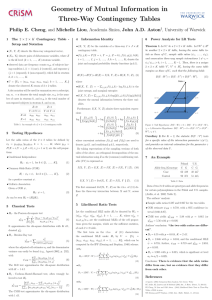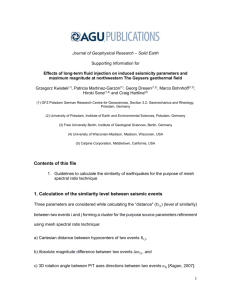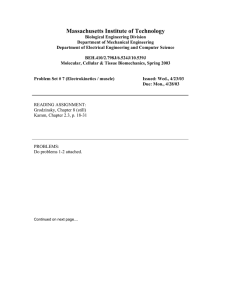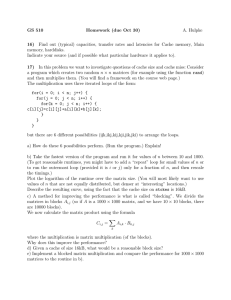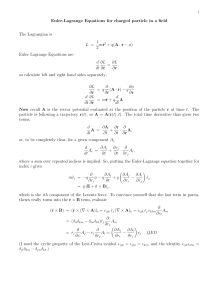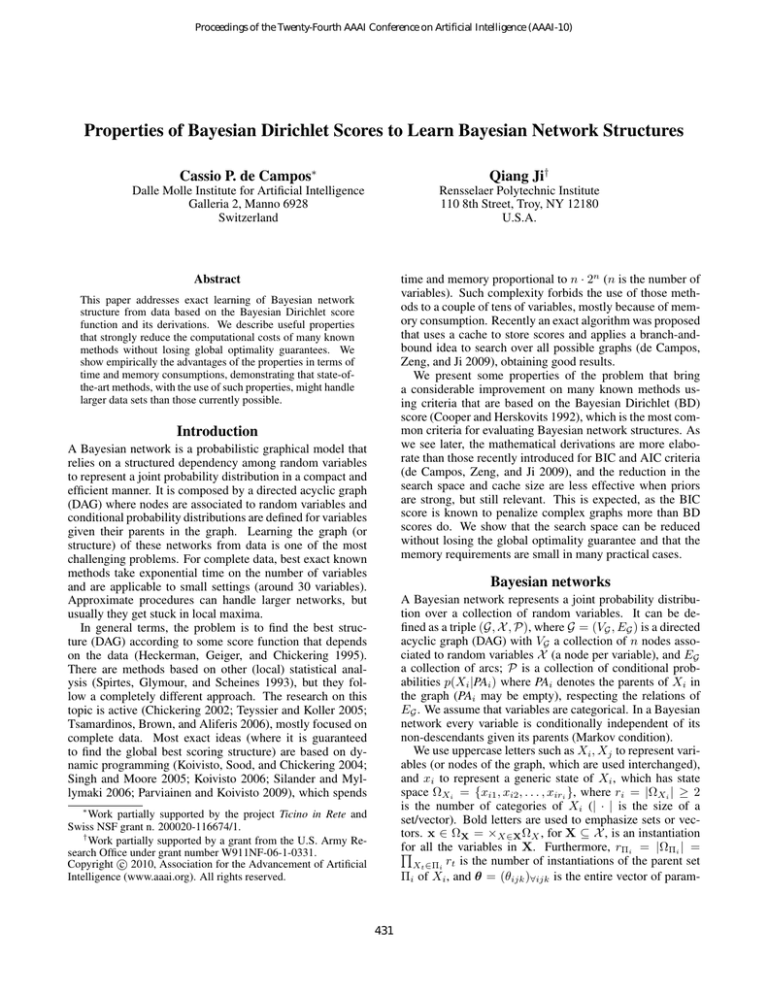
Proceedings of the Twenty-Fourth AAAI Conference on Artificial Intelligence (AAAI-10)
Properties of Bayesian Dirichlet Scores to Learn Bayesian Network Structures
Cassio P. de Campos∗
Qiang Ji†
Dalle Molle Institute for Artificial Intelligence
Galleria 2, Manno 6928
Switzerland
Rensselaer Polytechnic Institute
110 8th Street, Troy, NY 12180
U.S.A.
time and memory proportional to n · 2n (n is the number of
variables). Such complexity forbids the use of those methods to a couple of tens of variables, mostly because of memory consumption. Recently an exact algorithm was proposed
that uses a cache to store scores and applies a branch-andbound idea to search over all possible graphs (de Campos,
Zeng, and Ji 2009), obtaining good results.
We present some properties of the problem that bring
a considerable improvement on many known methods using criteria that are based on the Bayesian Dirichlet (BD)
score (Cooper and Herskovits 1992), which is the most common criteria for evaluating Bayesian network structures. As
we see later, the mathematical derivations are more elaborate than those recently introduced for BIC and AIC criteria
(de Campos, Zeng, and Ji 2009), and the reduction in the
search space and cache size are less effective when priors
are strong, but still relevant. This is expected, as the BIC
score is known to penalize complex graphs more than BD
scores do. We show that the search space can be reduced
without losing the global optimality guarantee and that the
memory requirements are small in many practical cases.
Abstract
This paper addresses exact learning of Bayesian network
structure from data based on the Bayesian Dirichlet score
function and its derivations. We describe useful properties
that strongly reduce the computational costs of many known
methods without losing global optimality guarantees. We
show empirically the advantages of the properties in terms of
time and memory consumptions, demonstrating that state-ofthe-art methods, with the use of such properties, might handle
larger data sets than those currently possible.
Introduction
A Bayesian network is a probabilistic graphical model that
relies on a structured dependency among random variables
to represent a joint probability distribution in a compact and
efficient manner. It is composed by a directed acyclic graph
(DAG) where nodes are associated to random variables and
conditional probability distributions are defined for variables
given their parents in the graph. Learning the graph (or
structure) of these networks from data is one of the most
challenging problems. For complete data, best exact known
methods take exponential time on the number of variables
and are applicable to small settings (around 30 variables).
Approximate procedures can handle larger networks, but
usually they get stuck in local maxima.
In general terms, the problem is to find the best structure (DAG) according to some score function that depends
on the data (Heckerman, Geiger, and Chickering 1995).
There are methods based on other (local) statistical analysis (Spirtes, Glymour, and Scheines 1993), but they follow a completely different approach. The research on this
topic is active (Chickering 2002; Teyssier and Koller 2005;
Tsamardinos, Brown, and Aliferis 2006), mostly focused on
complete data. Most exact ideas (where it is guaranteed
to find the global best scoring structure) are based on dynamic programming (Koivisto, Sood, and Chickering 2004;
Singh and Moore 2005; Koivisto 2006; Silander and Myllymaki 2006; Parviainen and Koivisto 2009), which spends
Bayesian networks
A Bayesian network represents a joint probability distribution over a collection of random variables. It can be defined as a triple (G, X , P), where G = (VG , EG ) is a directed
acyclic graph (DAG) with VG a collection of n nodes associated to random variables X (a node per variable), and EG
a collection of arcs; P is a collection of conditional probabilities p(Xi |PAi ) where PAi denotes the parents of Xi in
the graph (PAi may be empty), respecting the relations of
EG . We assume that variables are categorical. In a Bayesian
network every variable is conditionally independent of its
non-descendants given its parents (Markov condition).
We use uppercase letters such as Xi , Xj to represent variables (or nodes of the graph, which are used interchanged),
and xi to represent a generic state of Xi , which has state
space ΩXi = {xi1 , xi2 , . . . , xiri }, where ri = |ΩXi | ≥ 2
is the number of categories of Xi (| · | is the size of a
set/vector). Bold letters are used to emphasize sets or vectors. x ∈ ΩX = ×X∈X ΩX , for X ⊆ X , is an instantiation
for all the variables in X. Furthermore, rΠi = |ΩΠi | =
Q
Xt ∈Πi rt is the number of instantiations of the parent set
Πi of Xi , and θ = (θijk )∀ijk is the entire vector of param-
∗
Work partially supported by the project Ticino in Rete and
Swiss NSF grant n. 200020-116674/1.
†
Work partially supported by a grant from the U.S. Army Research Office under grant number W911NF-06-1-0331.
c 2010, Association for the Advancement of Artificial
Copyright Intelligence (www.aaai.org). All rights reserved.
431
eters such that θijk = p(xik |π ij ), where i ∈ {1, . . . , n},
j ∈ {1, ..., rΠi }, k ∈ {1, ..., ri }, and π ij ∈ ΩΠi . Because of the Markov condition, the Bayesian network represents a joint probabilityQdistribution by the expression
p(x) = p(x1 , . . . , xn ) = i p(xi |π i ), for every x ∈ ΩX ,
where every xi and π i agree with x.
Given a complete multinomial dataset D
=
{x1 , . . . , xN }, where xu ∈ ΩX is an instance of all
the variables, the goal of structure learning is to find a
graph G that maximizes a score function. In this paper, we
consider the well-known Bayesian Dirichlet (BD) score,
the BDe and the BDeu, and the K2 metric (Buntine 1991;
Cooper and Herskovits 1992; Heckerman, Geiger, and
Chickering 1995). The results refer to all criteria unless
otherwise specified. As done before in the literature, we assume parameter independence and modularity (Heckerman,
Geiger, and Chickering 1995).
Z
BD : sD (G) = log p(G) · p(D|G, θ) · p(θ|G)dθ ,
An important property of all such criteria is that their
functions are decomposable and can be written
terms of
Pin
n
the local nodes of the graph, that is, s(G) = i=1 si (Πi ),
with si (Πi ) =
!
rΠi
ri
X
X
Γ(αij )
Γ(αijk + nijk )
.
=
+
log
log
Γ(αij + nij )
Γ(αijk )
j=1
k=1
(2)
Equation (2) is used to compute the contribution of the node
Xi with parent set Πi to the global score of a graph.
Properties of the score functions
Local scores need to be computed many times to evaluate the
candidate graphs when we look for the best graph. Because
of decomposability, we can avoid to compute such functions
several times by creating a cache that contains si (Πi ) for
each Xi and each parent set Πi . Note that this cache may
have an exponential size on n, as there are 2n−1 subsets of
{X1 , . . . , Xn } \ {Xi } to be considered as parent sets. This
gives a total space and time of O(n·2n ·v) to build the cache,
where v is the worse case asymptotic time to compute the local score function at each node.1 Instead, we describe a collection of results that are used to obtain much smaller caches
in many practical cases. First, Lemma 1 is quite simple but
very useful to discard elements from the cache of each node
Xi . It was previously stated in (Teyssier and Koller 2005)
and (de Campos, Zeng, and Ji 2009), among others.
where the logarithmic is often used to simplify computations, p(θ|G) is the prior of θ for a given graph G, assumed
to be a Dirichlet with hyper-parameters α = (αijk )∀ijk
(which are assumed to be strictly positive):
p(θ|G) =
rΠi
n Y
Y
i=1 j=1
Γ(αij )
αijk −1
ri
Y
θijk
k=1
Γ(αijk )
,
Lemma 1. Let Xi be a node of G 0 , a candidate DAG for a
Bayesian network where the parent set of Xi is Π0i . Suppose
Πi ⊂ Π0i is such that si (Πi ) > si (Π0i ). Then Π0i is not the
parent set of Xi in the optimal DAG G ∗ .
P
where αij =
k αijk . Note that the hyper-parameters
(αijk )∀ijk depend on the graph G, so a more detailed noΠi
tation would be αijk
, which unless necessary we omit.
The task is to look for the best structure G ∗ =
argmaxG sD (G). From now on, the subscript D is omitted. We assume that there is no preference for any graph,
so p(G) is uniform and vanishes in the computations. Under
the assumptions, it has been shown (Cooper and Herskovits
1992) that for multinomial distributions,
s(G) = log
Proof. This fact comes straightforward from the decomposability of the score functions. Take a graph G that differs
from G 0 only on the parent set of Xi , where it has Πi instead of Π0i . Note that G is also a DAG (as G is a subgraph of G 0 built from the removal
which canPof some arcs,
not create cycles) and s(G) =
sj (Π0j ) + si (Πi ) >
j6
=
i
P
0
0
0
0
j6=i sj (Πj ) + si (Πi ) = s(G ). Hence any DAG G with
0
parent set Πi for Xi has a subgraph G with a better score
than that of G 0 , and thus Π0i is not the optimal parent configuration for Xi in G ∗ .
rΠi
n Y
Y
ri
Y
Γ(αijk + nijk )
Γ(αij )
, (1)
Γ(α
+
n
)
Γ(αijk )
ij
ij
i=1 j=1
k=1
where nijk indicates howP
many elements of D contain both
xik and π ij , and nij = k nijk . As before, note that the
values (nijk )∀ijk depend on the graph G (more specifically,
they depend on the parent set Πi of each Xi ), so a more prei
cise notation would be to use nΠ
ijk instead of nijk . Although
we avoid this heavy notation for simplicity (unless necessary
in the context), we ask the reader to keep in mind that values
nijk and αijk depend on the parent set of Xi .
The BDe score (Heckerman, Geiger, and Chickering
1995) assumes that αijk = α∗ · p(θijk |G), where α∗ is
known as the Equivalent Sample Size (ESS), and p(θijk |G)
is the prior probability for (xik ∧ π ij ) given G. The BDeu
score (Buntine 1991; Cooper and Herskovits 1992) assumes
∗
further that local priors are such that αijk becomes rΠα ri and
i
α∗ is the only free hyper-parameter, while the K2 metric assumes that αijk = 1 for all i, j, k.
Unfortunately Lemma 1 does not tell us anything about
supersets of Π0i , that is, we still need to compute scores for
all the possible parent sets and later verify which of them
can be removed. This would still leave us with Ω(n · 2n · v)
time and space requirements (although the space would be
reduced after applying the lemma). In the follow we describe how to avoid all such computations. First note that, in
the BD score, si (Πi ) =
X
X
Γ(αij )
Γ(αijk + nijk )
log
=
+
log
,
Γ(αij + nij )
Γ(αijk )
j∈Ji
k∈Kij
1
Note that the time to compute a single local score might be
large depending on the number of parents.
432
.
where Ji = JiΠi = {1 ≤ j ≤ rΠi : nij 6= 0}, because
nij = 0 implies that all terms cancel each other. In the
same manner, nijk = 0 implies that the terms of the inter.
Πi
= {1 ≤ k ≤
nal summation cancel out, so let Kij = Kij
ri : nijk 6= 0} be the indices of the categories of Xi such
.
Πi
be a vector with all inthat nijk 6= 0. Let KiΠi = ∪j Kij
dices corresponding to non-zero counts for Πi (note that the
symbol ∪ was used as a concatenation of vectors, as KiΠi
may have repetitions).
Note that the counts nijk (and conseP
quently nij = k nijk ) are completely defined if we know
the parent set Πi . Rewrite the score as follows:
X
si (Πi ) =
(f (Kij , (αijk )∀k ) + g((nijk )∀k , (αijk )∀k )) ,
Because v = argmaxx>0 − log Γ(x) and c = − log Γ(v),
X
− log Γ(1 +
αijk ) ≤ c.
k∈K
/ ij
If |Kij | = 1, then let Kij = {k}. We have nij ≥ 1 and
= − log
nij −1
X
αij
(αij + t)
= −f (Kij , (αijk )∀k ) − log
−
log
αijk
(αijk + t)
t=1
j∈Ji
P
with f (Kij , (αijk )∀k ) = log Γ(αij ) − k∈Kij log Γ(αijk )
and g((nijk )∀k , (αijk )∀k ) =
X
log Γ(αijk + nijk ).
− log Γ(αij + nij ) +
≤ − log αij + log αijk − f (Kij , (αijk )∀k ).
Lemma 3. For any Πi , (αijk )∀ijk > 0, and integers
(nijk )∀ijk ≥ 0, we have that g((nijk )∀k , (αijk )∀k ) ≤ 0
if nij ≥ 2.
P
Proof. If Q
nij ≥ 2, we use the relation Γ(x +P k ak ) ≥
Γ(x + 2) k Γ(ak ), for x ≥ 0, ∀k ak ≥ 1 and k ak ≥ 2.
This inequality is obtained in the same way as in Lemma 2,
but using a tighter Beta function bound:
−1
x + y (x + 1)(y + 1)
⇒
B(x, y) ≤
xy
x+y+1
k∈Kij
We do not need Kij as argument of g(·) because the set of
non-zero nijk is known from the counts (nijk )∀k that are already available as arguments of g(·). To achieve the desired
theorem that will be able to reduce the computational time
to build the cache, some intermediate results are necessary.
Lemma 2. For any Πi , (αijk )∀ijk > 0, and integers
(nijk )∀ijk ≥ 0, we have that g((nijk )∀k , (αijk )∀k ) ≤
c if nij ≥ 1, where c = − log Γ(v) ≈ 0.1214
and v = argmaxx>0 − log Γ(x) ≈ 1.4616. Furthermore, g((nijk )∀k , (αijk )∀k ) ≤ − log αij + log αijk −
f (Kij , (αijk )∀k ) if |Kij | = 1.
P
Proof.
ak ) ≥ Γ(x +
kP
Q We use the relation Γ(x +
1) k Γ(ak ), for x ≥ 0, ∀k ak ≥ 1 and k ak ≥ 1 (note
that it is valid even if there is a single element in the summation), which comes from the Beta function inequality:
x+y
Γ(x)Γ(y)
≤
=⇒ Γ(x+1)Γ(y +1) ≤ Γ(x+y +1),
Γ(x + y)
xy
P
where x, y > 0, and
P then we use y + 1 = t at (which is
possible because t at > 1 and thus y > 0), to obtain:
X
X
Y
Γ(x +
at ) ≥ Γ(x + 1)Γ(
at ) ≥ Γ(x + 1)
Γ(at ),
t
t
Γ(αij + nij )
Γ(αijk + nij )
!
nij −1
Γ(αij ) Y (αij + t)
Γ(αijk ) t=0 (αijk + t)
g((nijk )∀k , (αijk )∀k ) = − log
⇒ Γ(x + 2)Γ(y + 2) ≤ Γ(x + y + 2),
P
and the relation follows by using y + 2 =
t at and the
same derivation as before. Now,
P
Γ( 1≤k≤ri (αijk + nijk ))
Γ(αij + nij )
Q
Q
=
=
k∈Kij Γ(αijk + nijk )
k∈Kij Γ(αijk + nijk )
P
P
Γ( k∈K
/ ij αijk +
k∈Kij (αijk + nijk ))
Q
≥
=
k∈Kij Γ(αijk + nijk )
P
≥ Γ(2 +
k∈K
/ ij αijk ), obtained by renaming x =
P
α
and
ak = αijk + nijk , as we know that
/ ij ijk
Pk∈K
k∈Kij (αijk + nijk ) ≥ nij ≥ 2 and each ak ≥ 1. Finally,
t
(3)
(the last step is due to at ≥ 1 for all t, so the same relation
of the Beta function can be overall applied, because Γ(x +
1)Γ(y + 1) ≤ Γ(x + y + 1) ≤ Γ(x + 1 + y + 1)). Now,
P
Γ( 1≤k≤ri (αijk + nijk ))
Γ(αij + nij )
Q
= Q
=
k∈Kij Γ(αijk + nijk )
k∈Kij Γ(αijk + nijk )
P
P
Γ( k∈K
/ ij αijk +
k∈Kij (αijk + nijk ))
Q
=
≥
k∈Kij Γ(αijk + nijk )
P
P
≥ Γ(1 + k∈K
x = k∈K
/ ij αijk ), by renaming
/ ij αijk and
P
ak = αijk + nijk (we have that k∈Kij (αijk + nijk ) ≥
nij ≥ 1 and each ak ≥ 1). Thus g((nijk )∀k , (αijk )∀k ) =
X
Γ(αij + nij )
− log Q
≤ − log Γ(1 +
αijk ).
k∈Kij Γ(αijk + nijk )
Γ(αij + nij )
≤
k∈Kij Γ(αijk + nijk )
g((nijk )∀k , (αijk )∀k ) = − log Q
≤ − log Γ(2 +
X
αijk ) ≤ 0,
k∈K
/ ij
because Γ(2 +
P
k∈K
/ ij
αijk ) ≥ 1.
Lemma 4. Given two parent sets Π0i and Πi for a node Xi
such that Π0i ⊂ Πi , if si (Π0i ) >
X
Π
j∈Ji i :
Πi
|Kij |≥2
Πi
Πi
f (Kij
, (αijk
)∀k ) +
X
log
Π
j∈Ji i :
Πi
|Kij |=1
then Πi is not the optimal parent set for Xi .
k∈K
/ ij
433
Πi
αijk
0
Πi
αij
,
(4)
Π0
have to note that |Ki i | ≥ |KiΠi | (because the overall number of non-zero counts can only increase when we include
Π0
more parents), and αiji0 (for all j 0 ) are all less than 0.8349
(because the αs can only decrease when more parents are
included), thus we can apply the very same reasoning.
Proof. Using the results of Lemmas 2 and 3, si (Πi ) =
X
Πi
Πi
Πi
i
, (αijk
)∀k ) + g((nΠ
)
,
(α
)
)
≤
f (Kij
∀k
∀k
ijk
ijk
j∈Ji
X
Πi
Πi
Πi
i
, (αijk
)∀k ) + g((nΠ
f (Kij
ijk )∀k , (αijk )∀k )
Theorem 1 provides a bound to discard parent sets without
even inspecting them because of the non-increasing monotonicity of the employed bounding function when we increase the number of parents. Thus, the idea is to check the
validity of Theorem 1 every time the score of a parent set
Πi of Xi is about to be computed by taking the best score
of any subsets and testing it against the theorem. Whenever
possible, we discard Πi and do not even look into all its supersets. This result allows us to stop computing scores much
earlier than previous results do (Singh and Moore 2005), reducing the number of computations to build and store the
cache. Note that the constraint αij ≤ 0.8349 is not too
restrictive, because as parent sets grow, as ESS is divided
by larger numbers (it is an exponential decrease of the αs).
Hence, the values αij become quickly below the threshold.
Πi is also checked against Lemma 1 (which is stronger in the
sense that instead of a bounding function, the actual scores
are directly compared). However it cannot help us to avoid
analyzing the superset of Πi . As we see in the experiments,
the practical size of the cache after the application of the
properties is small even for considerably large networks, and
both Lemma 1 and Theorem 1 help reducing the cache size,
while Theorem 1 also help to reduce computations.
Π
j∈Ji : |Kiji |≥2
X
+
Π
Πi
Πi
≤
+ log αijk
− log αij
0
Π
j∈Ji i : |Kiji |=1
X
X
Πi
Πi
, (αijk
)∀k ) +
f (Kij
log
Π
Π
j∈Ji i :|Kiji |=1
Π
Π
j∈Ji i :|Kiji |≥2
Πi
αijk
0
Πi
αij
,
which by the assumption of this lemma, is less than si (Π0i ).
Thus, we conclude that the parent set Π0i has better score
than Πi , and the desired result follows from Lemma 1.
Lemma 5. Given the BDeu score, (αijk )∀ijk > 0, and integers (nijk )∀ijk ≥ 0 such that αij ≤ 0.8349 and |Kij | ≥ 2
for a given j, then f (Kij , (αijk )∀k ) ≤ −|Kij | · log ri .
Proof. Using αijk ≤ αij ≤ 0.8349 (for all k), we have
αij
)=
ri
αij
αij
log Γ(αij ) − |Kij | log Γ(
+ 1) + |Kij | log
=
ri
ri
f (Kij , (αijk )∀k ) = log Γ(αij ) − |Kij | log Γ(
log Γ(αij ) − |Kij | log
|Kij | log
Γ(
αij
ri
+ 1)
αij
− |Kij | log ri =
Experiments
We perform experiments to show the benefits of the reduced
cache and search space.2 We use data sets available at the
UCI repository (Asuncion and Newman 2007). Lines with
missing data are removed and continuous variables are discretized over the mean into binary variables. The data sets
are: adult (15 variables and 30162 instances), breast (10
variables and 683 instances), car (7 variables and 1728 instances) letter (17 variables and 20000 instances), lung (57
variables and 27 instances), mushroom (23 variables and
1868 instances), nursery (9 variables and 12960 instances),
Wisconsin Diagnostic Breast Cancer or wdbc (31 variables
and 569 instances), zoo (17 variables and 101 instances).
The number of categories per variables varies from 2 to
dozens in some cases (we refer to UCI for further details).
Table 1 presents the time in seconds (first block) and number of steps in local score evaluations (second block) for the
cache construction, after applying Lemma 1 and Theorem 1.
The last block shows the percentage of the full cache that
was discarded by each of them. For instance, the cell “56;
29” indicates that 56% of the full cache was discarded by
applying Lemma 1, while 29% was not even evaluated (because of Theorem 1). Each column presents the results for a
distinct data set. In different lines we show results for ESS
equals to 0.1, 1, 10 and 100. Note that discarding elements
by Lemma 1 does not reduce the number of steps to build the
Γ(αij )1/|Kij | αij
− |Kij | log ri .
α
Γ( riji + 1)
α
Now, Γ(αij )1/|Kij | αij ≤ Γ( riji + 1), because ri ≥ 2,
|Kij | ≥ 2 and αij ≤ 0.8349. It is interesting to point out
that 0.8349 is in fact a bound for αij that ensures this last
inequality to hold when ri = |Kij | = 2, which is the worst
case scenario (greater values of them make the left-hand side
decrease and the right-hand side increase).
Theorem 1. Given the BDeu score and two parent sets Π0i
Πi
and Πi for a node Xi such that Π0i ⊂ Πi and αij
≤ 0.8349
Πi
0
for every j, if si (Πi ) > −|Ki | log ri then neither Πi nor
any superset Π0i ⊃ Πi are optimal parent sets for Xi .
Proof. We have that si (Π0i ) > −|KiΠi | log ri =
X
X
Πi
−|Kij
| log ri +
− log ri ,
Π
Π
j∈Ji i : |Kiji |≥2
Π
Π
j∈Ji i : |Kiji |=1
which by Lemma 5 is greater than or equal to
X
X
Πi
Πi
f (Kij
, (αijk
)∀k ) +
Π
Π
j∈Ji i : |Kiji |≥2
Π
− log ri .
Π
j∈Ji i : |Kiji |=1
Now, Lemma 4 suffices to show that Πi is not a optimal parent set. To show the result for any superset Π0i ⊃ Πi , we just
2
The software is available online through the web address
http://www.ecse.rpi.edu/∼cvrl/structlearning.html
434
Table 1: Time and number of steps (local score evaluations) used to build the cache. The last block contains the percentage
of the potential full cache that was discarded by applying Lemma1 and Theorem1, respectively (only Theorem1 reduces the
number of steps). Results for BDeu score with ESS varying from 0.1 to 100 are presented.
ESS adult
breast
car
letter
lung
mushroom nursery wdbc
zoo
0.1
89.3
0.0
0.0
429.4 2056.3
357.9
0.7
2891.8
1.7
Time
1
91.6
0.0
0.0
440.4 1398.7
278.7
0.7
2692.7
1.7
(in seconds)
10
91.6
0.0
0.0
438.1 1098.0
268.9
0.7
2763.7
1.7
100
53.8
0.0
0.0
93.3 1428.8
318.8
0.6
3272.8
0.8
0.1
217.4
210.5
28.8
220.1
230.8
224.0
211.2
227.9
219.8
217.4
210.5
28.8
220.1
230.2
223.6
211.2
227.8
219.7
Number of
1
17.4
10.4
8.8
20.1
29.8
23.5
11.2
27.9
2
2
2
2
2
2
2
2
219.6
Steps
10
16.5
10.4
8.8
17.9
30.2
23.7
11.1
28.0
100
2
2
2
2
2
2
2
2
217.9
17.9
12.3
8.8
20.1
31.1
26.5
11.2
28.4
2
2
2
2
2
2
2
2
220.1
Worst-case
% of reduction
0.1 56; 29 15; 72 95; 0 99; 0 61; 22
8; 83
97; 0
69; 27 48; 20
implied by Lemma1;
1
56; 29 14; 72 94; 0 99; 0 38; 46
7; 87
97; 0
65; 33 47; 23
56; 29 13; 74 86; 0 97; 0 24; 59
6; 88
95; 0
65; 32 41; 30
and % of reduction
10
obtained from Theorem1 100 31; 63 6; 73 34; 0 7; 77 24; 49
7; 86
67; 4
68; 25
9; 77
cache, because they needed to be processed anyway, while
Theorem 1 does imply in a smaller number of steps. The line
worst-case presents the number of steps to build the cache
without using Theorem 1. As we see through the log-scale
in which they are presented, the reduction in number of steps
has not been exponential, but still computational significant
in many cases. For instance, all the experiments were run
using less than 2GB of memory. Even a factor of five could
make hard to run it because of the memory usage.
The benefits of the application of these results imply in
performance gain for many algorithms in the literature to
learn Bayesian network structures, as long as they only need
to work over the (already precomputed) small cache. In Table 2 we present the final cache characteristics, where we
find the most attractive results, for instance, the small cache
sizes when compared to the worst case. The first block contains the maximum number of parents per node (averaged
over the nodes). The worst-case is the total number of nodes
in the data set minus one, apart from lung (where we have
set a limit of at most six parents) and wdbc (with at most
eight parents). The second block shows the cache size for
each data set and distinct values of ESS. We also show the
results of the BIC score and the worst-case values for comparison. We see that the actual cache size is orders of magnitude smaller than the worst case situation. It is also possible to analyze the search space reduction implied by these
results by looking the implications to the search space of
structure learning. We must point out that by search space
we mean all the possible combinations of parent sets for all
the nodes. Eventually some of these combinations are not
DAGs, but are still being counted. However, there are two
considerations: (i) the precise counting problem is harder to
solve (in order to give the exact search space size), and (ii)
most structure learning algorithms run over more than only
DAGs, because they need to look at the graphs (and thus
combinations of parents) to decide if they are acyclic or not.
In these cases, the actual search space is not simply the set
of possible DAGs, even though the final solution will be a
DAG.
An expected but important point to emphasize is the correlation of the prior with the time and memory to build the
cache. As larger ESS (and thus the prior towards the uniform) as slower and more memory consuming is the method.
That is explained by the fact that smoothing the different parent sets by the stronger prior makes harder to see large differences in scores, and consequently the properties that would
reduce the cache size are less effective. The two largest data
sets in terms of number of variables (lung and wdbc) were
impossible to be processed without setting up other limits
such as maximum number of parents or maximum number
of free parameters in the node (we have not used any limit
for the other data sets). We used an upper limit of six parents per node for lung and eight for wdbc. This situation
deserves further study so as to clarify whether it is possible
to run these computations on large data sets and large ESS.
It might be necessary to find tighter bounds if at all possible,
that is, stronger results than Theorem 1 to discard unnecessary score evaluations earlier in the computations.
Conclusions
This paper describes novel properties of the Bayesian
Dirichlet score functions to learn Bayesian network structure from data. Such properties allow the construction of a
cache with all possible local scores of nodes and their parents with reduced memory consumption, which can later be
used by searching algorithms. For instance, memory consumption was a bottleneck for some algorithms in the literature, see for example (Parviainen and Koivisto 2009). This
implies in a considerable reduction of the search space of
graphs without losing the global optimal structure, that is,
it is ensured that the overall best graph remains in the reduced space. In fact the reduced memory and search space
potentially benefits most structure learning methods in the
literature, for example dynamic programming, branch and
bound, some types of local search, simulated annealing, genetic programming, etc, and it makes possible to the very
same algorithms to find the global solution in instances before not handled, just by working over the reduced space.
435
Table 2: Final cache characteristics: maximum number of parents (average by node), actual cache size, and (approximate)
search space implied by the cache. Worst-cases are presented for comparison (those marked with a star are computed using the
constraint on the number of parents that was applied to lung and wdbc). Results with ESS from 0.1 to 100 are presented.
ESS adult breast
car
letter
lung
mushroom nursery wdbc
zoo
0.1
2.1
1.0
0.7
4.5
0.1
4.1
1.2
1.3
1.4
Maximum Number
1
2.4
1.0
1.0
5.2
0.4
4.4
1.7
1.7
1.9
of Parents
10
3.3
1.0
1.9
5.9
3.0
4.8
2.1
3.1
3.4
100
5.9
2.0
3.1
6.0
6.0
7.0
3.2
6.0
6.0
Worst-case
14.0
9.0
6.0
16.0
6.0∗
22.0
8.0
8.0∗
16.0
0.1
24.2
21.5
21.1
28.2
20.2
28.5
21.9
23.6
23.3
4.8
1.9
1.6
9.0
0.8
8.9
2.4
4.9
Final Size
1
2
2
2
2
2
2
2
2
24.4
6.3
3.3
3.0
10.5
10.7
9.8
3.5
12.1
of the Cache
10
2
2
2
2
2
2
2
2
28.9
9.1
5.5
5.4
13.3
19.2
13.5
6.2
19.6
100
2
2
2
2
2
2
2
2
213.1
9.3
4.7
4.5
15.3
11.5
13.0
5.6
12.9
2
2
2
2
2
2
2
2
210.9
BIC
Worst-case (n2n−1 )
217.9
212.3
28.8
220.1
231.1∗
226.5
211.2
228.4∗ 220.1
0.1
254.1
213.3
26.3 2129.0
28.2
2175.7
211.6
290.3
239.3
Implied Search
1
262.1
217.1
28.3 2144.8
233.1
2186.0
215.4
2132.7 260.3
Space (approx.)
10
291.6
233.2 220.6 2176.1 2612.0
2221.8
227.3
2375.1 2150.7
136.1
55.2
37.7
226.1
1092.9
310.5
55.9
2
2
2
2
2
2
2606.1 2221.8
100 2
71
23
10
188
330
180
17
BIC
2
2
2
2
2
2
2
2216
2111
210
90
42
272
1441∗
506
72
727∗
Worst-case
2
2
2
2
2
2
2
2
2272
We show through experiments with public data sets that requirements of memory are considerably smaller., as well as
the resulting reduced search space.
There is certainly much further to be done. The most important question is whether the bound of Theorem 1 can be
improved or not. We are actively working on this question.
Furthermore, the experimental analysis can be extended to
further clarify the understanding of the problem, for instance
how the ESS affects the results. The comparison of structures and what define them to be good is an important topic.
For example, accuracy of the generated networks can be
evaluated with real data. On the other hand, that does not
ensure that we are finding the true links of the underlying
structure, but a somehow similar graph that produces a close
joint distribution. For that, one could use generated data and
compare the structures against the one data were generated
from it. Besides that, considerably large data sets will hardly
be handled by exact methods, so an study on how the properties may help fast approximate methods is also a desired
goal.
de Campos, C. P.; Zeng, Z.; and Ji, Q. 2009. Structure learning of Bayesian networks using constraints. In Int. Conf. on
Machine Learning, 113–120.
Heckerman, D.; Geiger, D.; and Chickering, D. M. 1995.
Learning bayesian networks: The combination of knowledge and statistical data. Machine Learning 20(3):197–243.
Koivisto, M.; Sood, K.; and Chickering, M. 2004. Exact
bayesian structure discovery in bayesian networks. J. of Machine Learning Research 5:549–573.
Koivisto, M. 2006. Advances in exact bayesian structure
discovery in bayesian networks. In Conf. on Uncertainty in
AI, 241–248.
Parviainen, P., and Koivisto, M. 2009. Exact structure discovery in bayesian networks with less space. In Conf. on
Uncertainty in AI, 2009.
Silander, T., and Myllymaki, P. 2006. A simple approach
for finding the globally optimal bayesian network structure.
In Conf. on Uncertainty in AI, 445–452.
Singh, A. P., and Moore, A. W. 2005. Finding optimal
bayesian networks by dynamic programming. Technical report, Carnegie Mellon University. CMU-CALD-05-106.
Spirtes, P.; Glymour, C.; and Scheines, R. 1993. Causation,
Prediction and Search. Springer-Verlag.
Teyssier, M., and Koller, D. 2005. Ordering-based search:
A simple and effective algorithm for learning bayesian networks. In Conf. on Uncertainty in AI, 584–590.
Tsamardinos, I.; Brown, L. E.; and Aliferis, C. 2006. The
max-min hill-climbing bayesian network structure learning
algorithm. Machine Learning 65(1):31–78.
References
Asuncion,
A.,
and
Newman,
D.
2007.
UCI
machine
learning
repository.
http://www.ics.uci.edu/∼mlearn/MLRepository.html.
Buntine, W. 1991. Theory refinement on Bayesian networks.
In Conf. on Uncertainty in AI, 52–60.
Chickering, D. M. 2002. Optimal structure identification
with greedy search. J. of Machine Learning Research 3:507–
554.
Cooper, G. F., and Herskovits, E. 1992. A bayesian method
for the induction of probabilistic networks from data. Machine Learning 9:309–347.
436


